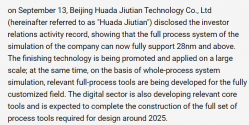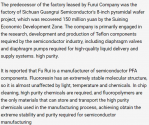I share this to read what people have to say.All of these have already been discussed. Why post these again?
You are using an out of date browser. It may not display this or other websites correctly.
You should upgrade or use an alternative browser.
You should upgrade or use an alternative browser.
Chinese semiconductor industry
- Thread starter Hendrik_2000
- Start date
- Status
- Not open for further replies.
View attachment 97474
Still some people question why is China investing so much money in third generation materials like SiC and GaN.
- In this work, a 2.5 × 2.5 mm2 large-area 4H-SiC Schottky barrier photodiode with a grid-shaped semitransparent metal electrode is designed and fabricated for extreme ultraviolet (EUV) detection
- Based on a synchrotron radiation source, the photo-response characteristics of the photodiode is measured between 5nm and 140nm
- EUV detectors are the key component used for monitoring and calibrating photon beam intensity
On a related note, does anybody know how photoresists would react with uber powered synchrotron generated EUV source power in the multi-kilowatt range? I imagine a synchrotron driven EUV litho machine would simply run faster. With that much power, photoresist parameters could be looser such that photoresists would be an easier bottleneck to crack vs photoresist designed for much lower powered EUV light sources. Photoresist over-exposure might also become an issue on the flip side so comments to this are appreciated.
Damn, asking the real questions. Are you in semiconductor industry?Very interesting!
- In this work, a 2.5 × 2.5 mm2 large-area 4H-SiC Schottky barrier photodiode with a grid-shaped semitransparent metal electrode is designed and fabricated for extreme ultraviolet (EUV) detection
- Based on a synchrotron radiation source, the photo-response characteristics of the photodiode is measured between 5nm and 140nm
- EUV detectors are the key component used for monitoring and calibrating photon beam intensity
So, this was obviously used for testing EUV light, sourced from either the SSMB or SSRF, or both. Even more interesting that 5nm-140nm wavelengths were tested. Unlike LPP generated EUV, synchrotrons can easily tune the wavelength and in a very real sense make up for photoresist sensitivity that might be most optimal for wavelengths other than 13.5nm. Imagine using 11.2nm instead of 13.5nm and realizing <7nm features using the same 7nm process. Conversion efficiency isn't as big an issue so tuning the wavelength would achieve what would otherwise need lithium powered LPP EUV.
On a related note, does anybody know how photoresists would react with uber powered synchrotron generated EUV source power in the multi-kilowatt range? I imagine a synchrotron driven EUV litho machine would simply run faster. With that much power, photoresist parameters could be looser such that photoresists would be an easier bottleneck to crack vs photoresist designed for much lower powered EUV light sources. Photoresist over-exposure might also become an issue on the flip side so comments to this are appreciated.
Synchrotron EUV source is really good for those reasons - maintenance, tunability and power.
For example 13.5 nm EUV absorbance causes photopolymerization of even ppb organics onto optical surface, which requires vacuum wafer chamber and H2 purging of optics chamber. The Sn droplet is more or less isotropic emitter so the EUV radiation is not collimated by default. and you have to have a Sn contamination management system.
Synchrotron is clean (no vaporizing tin!!), tunable as you said and very high output.
IMO a successful synchrotron EUV source would be like the revolution from incandescent light bulb to CFL.
broadsword
Brigadier
Any idea how far is China in synchrotron EUV research?
KW source is being done at R&D level.Any idea how far is China in synchrotron EUV research?
The ASML guys are milking dry those immersion scanners. Probably current EUV export controls to China are forcing the company to work on these legacy tools even if they don't want to anymore.To note the availability of the new NXT:2100i successor of NXT:2050i and described as "for the most critical DUV layers", I guess this is a 5-7nm machine. If SMIC succeed in procure at least 20 of these new toys, it's (almost) game over for US banning policy.
hahaha, this is why the US is madly banning chip manufacturing equipment below 14nm to China.Official ASML financial report for first half of 2022
Some highlights:
1) "With regards to new lithography systems, we recognized revenue for 127 DUV and 15 EUV systems in the first half of 2022, compared to 126 DUV and 16 EUV systems in the first half of 2021"
2) "DUV – Continuing innovation in our latest-generation immersion system NXT:2050i and introduction of the dry system
XT:860N. Continued developments for the next generation of scanners, NXT:2100i for the most critical DUV layers, and
NXT:870 for break-through productivity in the KrF dry market. We shipped the first NXT:870 to a customer. With a 27%
increase in throughput we take a major step in responding to the industry’s demand for KrF tools and wafer output"
3) Pag 20: List of new sales per machine types (sold but probably still not delivered), 15 EUV, 39 DUV immersion, 99 others
4) Pag21: List of new sales by geographic region: China 1513 million € on 8965 total -> China almost 17% of revenues
So if we assume that 17% of revenues corresponds to a 20-25% of total machines delivered to China (because EUV machines, banned in China, are much more expensive and in the revenues weight more), we can assume 35-45 machines delivered to China in the first half of 2022.
To note the availability of the new NXT:2100i successor of NXT:2050i and described as "for the most critical DUV layers", I guess this is a 5-7nm machine. If SMIC succeed in procure at least 20 of these new toys, it's (almost) game over for US banning policy.
- Status
- Not open for further replies.


